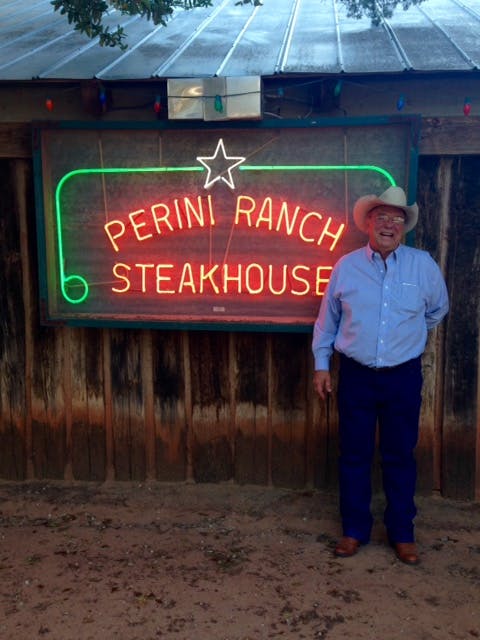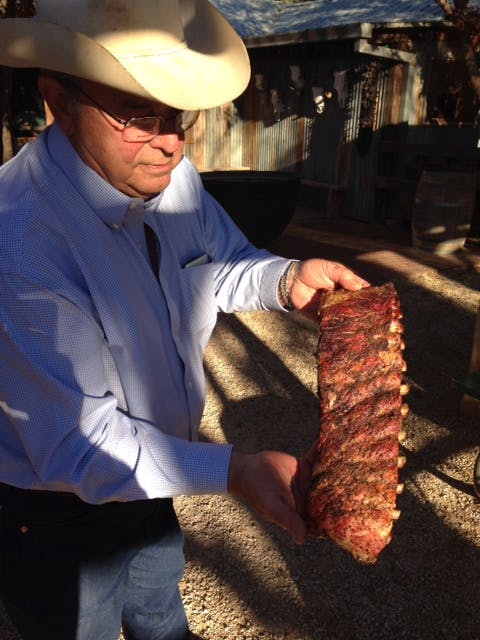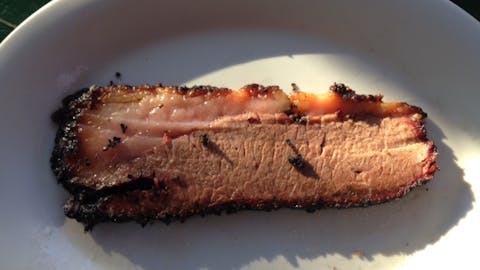 Co-Owner: Perini Ranch Steakhouse; Opened 1983
Co-Owner: Perini Ranch Steakhouse; Opened 1983
Age: 71
Smoker: Indirect Heat Wood-Fired Pit
Wood: Mesquite
Tom Perini cooks with mesquite. It might be in the form of coals for direct heat cooking, or the active flames of burning logs for grilling steaks. That mesquite also fuels an offset smoker for the smoked prime rib served in the restaurant and brisket for Perini’s many catering gigs. “I think the fun thing is that we cook with fire, and it’s not always barbecue,” he tells me.
Perini has been playing with meat and fire for much longer than the restaurant’s been open when he learned that he liked cooking on the ranch a lot more than being a cowboy. It took almost two decades, but he finally learned that the way to keep the family ranch relevant wasn’t in the buying and selling of live cattle, but in cooking beef. He opened a restaurant that took years to become popular, but has now become a Texas icon for steaks.
We talked outside the restaurant on a warm December afternoon at one of the back picnic tables. A few deer walked by, and Tom said nonchalantly “We feed them. We give them the leftover lettuce.” I was an answer as laid back as most things go in Buffalo Gap, Texas.
Daniel Vaughn: How did you start cooking barbecue?
Tom Perini: What we used to do years ago is go out with a backhoe and dig a trench, probably four feet deep. We would fill it with mesquite and oak stumps and burn it down. Two days later you’d have coals a foot deep and all the walls of the pit were hot. We’d put two inch pipes across the pit, stretch bull wire across, and put our briskets on. We’d just lay tin right overtop. The ground was so hot it was like an oven. The heat was going straight up. We’d take the tin off and flip them and mop them, then put the tin back on.
DV: Where did you cook like that?
TP: Right here in Buffalo Gap.
DV: Did you grow up here?
TP: In Abilene, but my parents bought this place in 1952, I grew up out here as a little boy. We’d ride horses. My father passed away in ’65 and I moved back to the ranch. I’ve been here ever since. I raised cattle for eighteen years then got into the food business. I don’t have a degree from some culinary place, but I went around cooking for cowboys. When you put too much salt in the beans, they’ll tell you real quick. You learn to cook things that people like. I opened this in ’83.
DV: Were all the cattle you raised here on the ranch?
TP: Here, and I had leases all over Texas. I was of the theory that the more land and cattle you had, the more money you could make. I never plugged in the factor that it also meant the more money you could lose.
DV: Were you forced into the restaurant business?
TP: No. A dear friend of mine, Watt Matthews, had a ranch up near Albany – 45,000 acres. Watt was my mentor. He had graduated from Princeton. He loved rare meat, bourbon whiskey, and had never been married. I thought “This is my man.” This was the pinnacle of pinnacles. He had more girlfriends than I had. He died at ninety-eight years old. I went to Watt in ’82. I’d been ranching about eighteen years and I told him “I can’t make it work.” I had a chuckwagon out on the ranch, and I would cook on the chuckwagon because being a chuckwagon cook is easier than being a cowboy. I’d catered for Watt and a few other ranches in the area – The Swenson Land & Cattle Company, The Pitchfork Ranch. I’d bring the chuckwagon up. They’d supply the mesquite wood and beef and I’d cook it. At the end they’d give everybody a hundred dollar bill and that was it. I’d do 800 person parties for Watt, and he got me from ranching and catering to the restaurant business. Incidentally, there’s no comparison between the two. Restaurants have full time employees. Catering has employees only when you need them. That was one of my first lessons. This has been a long process, it’ll be thirty-two years in March, and it has not been easy. The first twelve years were tough.
DV: Were the problems borne from learning the restaurant business?
TP: Well, that and look where we are? You drive down here and get a hamburger, you can’t even see it from the highway, but we had a lot of guys come out to eat and drink, it just took a long time. We are a true destination restaurant. We have a demographic study we do every year with people’s zip codes. Sixty percent of our business is within a hundred fifty miles of here. That covers Fort Worth, Lubbock, and Big Spring. Thirty percent covers the rest of Texas, and ten percent is outside the state. The people in Abilene have to depend on the population of Abilene while I’ve got people driving in as we speak to have dinner. The furthest we had was a guy from Japan who flew here from Tokyo to eat lunch. He was a big client of American Express. They ate everything they could.
DV: I can’t imagine you ever expected that when you opened. What was the goal back then?
TP: I don’t remember. Those first twelve years were tough, and I had a very understanding mother that loaned me money. I just didn’t know she had kept track of it so well, but she had [laughing]. She told me years ago “You’ve got to do something different to hold this section together” – this 640 acres. It’s not big enough to be a productive ranch. We have longhorns here, but that’s just because people want to see them. I’d go in to see her and say “Mother, I need $2000 to make payroll,” and she’d lend it to me. It got better after ten or twelve years.
DV: That’s a long time to wait for things to get better for a restaurant.
TP: I had people come in here and tell me I should do this or that, but I stuck with it. Our whole deal is simple food. I want the food to look good, I want it taste good, and I want you to be able to recognize it. I don’t want the stacked stuff that you get at restaurants now that you don’t know if you need a knife and fork or if you pick it up with your hands. I don’t want that. It’s a hamburger. Pick it up.
DV: About that hamburger, it wasn’t always on the menu, was it?
TP: No, it wasn’t. It’s a half pound, hand-formed patty. Texas Monthly put it on their list of the best. The Today show said we had the best, but now think about this. Here’s a half pound hamburger that’s $10. That’s a big hamburger, so a husband and wife cut the son-of-a-gun in half and have a glass of iced tea. From a cash flow standpoint, that’s not good versus a $35 steak and a bottle of wine. We ran a special for a burger and Burgundy. We sell a lot. I thought about just opening a hamburger joint just to get it away from here.
DV: What is your best seller?
TP: Ribeyes for sure. I like the bone-in ribeye. You know the difference between a nice restaurant and a joint? This is a joint, and here you pick up the bone and chew on it.
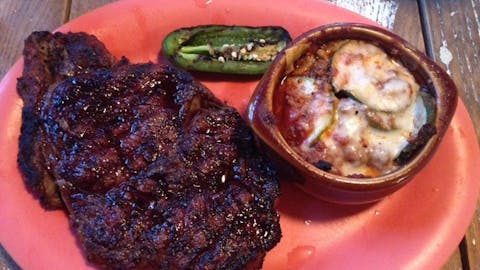
DV: You cook only with wood, so do you consider what you do here barbecue?
TP: The word barbecue is a confusing word…
DV: …And a loaded word in Texas.
TP: It damn sure is. When I think of barbecue, I think of ribs and brisket that’s cooked slow with smoke. In the case of our steaks, it’s a hot fire over flames. It’s still wood. Our prime rib is smoked, but I don’t consider it barbecue because we cook it at 325 degrees. The outside crust has all those wonderful flavors, but I wouldn’t call it barbecue. When you define the word barbecue, is it fire? This is where you get to an area of fluctuation. We cook all of our meat on mesquite coals or live fire.
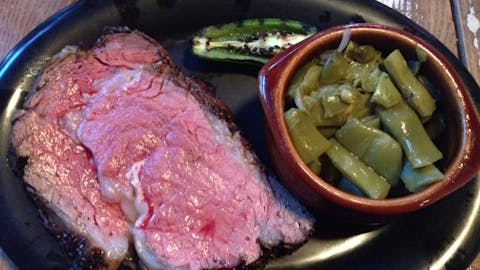
DV: What is it about this area of the state that does so much of the steak over live fire? There’s the Beehive, Joe Allen’s, and a number of others.
TP: This is just what we do in this area. Years ago when I was growing up as a kid, you couldn’t get anything to drink here. I was driving when I was fourteen years old. I would drive from Abilene to Lowake, beyond Ballinger, about an hour and a half away. There was the Lowake Steakhouse and I used to take dates down there to have a few beers. I never thought about driving back. They would serve beer in a fishbowl. It was a great big glass that probably held two beers in it. I found out real early that they wouldn’t ask you how old you were if you could pick that fishbowl up and not do this [wobbling his hand]. I practiced. I had a fishbowl and I practiced for two weeks. I could walk in that place and drink a fishbowl like a pro at fourteen. Anyway, they cut their meat, and most of it was sirloin. They cooked it all on a flat grill. They would get a steak and sprinkle flour and garlic on both sides. On the grill they cooked it in beef tallow. It had a little crust on it. The flour made it brown. They’d bring that to the table and slice it for you. No fire, just like Zentner’s [in San Angelo] and these other early steakhouses. It was all flat grill.
DV: What made you decide to do it differently?
TP: I don’t know. This is the way I did chuckwagon cooking. The flat grill is an easier way to cook steak because you know the temperature. A mesquite fire is a little more iffy. When we opened this place and I called it Perini Ranch Steakhouse, the word steakhouse was a negative word. I did mesquite because in those early days it was all native. Now I drive all around Texas and it’s all steakhouse this and mesquite that. In the old days I was on the edge, but in the chuckwagon we did everything with fire.
DV: Did people think of it as a dirty way of cooking?
TP: I don’t know, but it was a heat source that we had. People will ask why we don’t use hickory or pecan. I say “Look around.” Why am I going to bring in hickory? I’m in mesquite country, and I’m going to cook with mesquite. We go through between five and ten cords a month.
DV: Do you chop it all down yourself?
TP: No. I used to do that, and I found out real quick…I have contractors do it now.
DV: When you opened you’ve said it was a barbecue place, but you called it a steakhouse anyway. When did you give up on the brisket?
TP: I don’t remember the day, It was a year or so in. I just asked the staff “What is the problem? What do you get the most complaints about?” They said it was that the brisket’s dry, and that’s because it had been reheated. You can chop it up and put sauce on it, but you can’t keep that moisture in the sliced brisket.
DV: But the ribs never came off the menu. Were you just happier with them?
TP: Well, we were cooking them all the time. A brisket will serve fifteen people. A half rack of ribs serves one or two, so I’m moving those.
DV: How long do the ribs cook?
TP: Three or three and a half hours.
DV: On the smoker?
TP: Yes. We season them and slow cook. There’s no sauce on them. I don’t put sauce on anything but on the table. I’m a dry rub person.
DV: Are there any secrets to the steak seasoning?
TP: We make our own steak rub, but it’s simple. There’s garlic, salt, and pepper. It’s nothing fancy. But we have different seasonings. I have one for lamb chops, everything has a different seasoning because I don’t want them all to taste alike.
DV: What do you normally eat here?
TP: I’m a ribeye guy.
DV: A ribeye a day keeps the doctor away?
TP: Honestly, people do think I eat ribeyes everyday, but I don’t. But about once a week I crave it. I eat a lot of fried catfish too.
[A brisket comes out to the table]
TP: There’s some sauce on the side if you want it, but we don’t put sauce on it when we’re cooking it. We do mop it though.
DV: What’s in the mop?
TP: Boiled vinegar and – let me tell you a trade secret – beef tallow. When we trim a brisket we get all the fat and cook it down. That becomes the oil. It’s not a foreign flavor. Everybody has a preference, but I’m a black pepper guy. It’s a visual that I like. I think the brisket has a wonderful flavor. The fat has a completely different flavor. Years ago, I used to make all of our hamburgers out of brisket. Now it’s chuck.
DV: Perini Ranch has become an incredibly successful steakhouse, and is well known, especially across Texas. But outside of Texas you’ve become known for your whole beef tenderloin. How did that become such a hot item to ship?
TP: A blind pig finds an acorn every once in a while. We had been asked in 1995 to cook at the James Beard House. It was a huge culinary honor. It was the biggest thing we’d ever done. We had to take a crew up to New York and donate all the food. It cost us about $10,000. This was back just when things started to turn around. I talked to a friend who was a marketing guy. I said “What can I do while I’m up there to justify this expenditure?” He said “why don’t you send out about twenty of those tenderloins to different magazines? If you get one or two articles, then you can justify that expenditure.” Parade magazine said they loved it, and the New York Times called and said they wanted another tenderloin. Food & Wine said they loved it, but I had to buy a $10,000 ad. We cooked at the James Beard House. It was very successful, then we came back home. That was in June. Later that year in September or October the New York Times called. You gotta remember, I’m out in Buffalo Gap with dogs barking out back and this guy says he’s a fact checker for the New York Times. I had no idea what that meant. I thought he was checking my fax machine. He asked about the tenderloin and I told him. He asked me how much, and I told him. He was asking all these questions and I asked him what this was all about. He said he couldn’t tell me, but he asked “Do you have a 1-800 number?” I had just recently gone to a rotary phone from a crank which I thought was big time, and he was asking if I had a 1-800 number. He said to call him back that day if I could find a 1-800 number. I called my local phone co-op and got one and called him back. At 4:00 in the morning I got a call from and old girlfriend who asked if I’d seen the New York Times. I’m in Buffalo Gap. It takes for days for the sumbitch to get here. She read me the article. The New York Times had chosen us as the Tasting Star for mail order gifts for 1995. The problem was, I didn’t have a mail order company. I had just cooked some tenderloins in the back and sent them. I had these calls coming in from the East Coast ordering tenderloins, and I’m going “Oh no!” I found out real quick that if I was not in a USDA plant, and I shipped the things outside Texas, that I’d have about a $30,000 fine. I went down to Ballinger, Texas where they had a USDA plant. I worked out a deal with them and we started cooking tenderloins. What had happened was that we sent that box to the New York Times to try and get a story out of it. I didn’t know there was a contest going on, but this secretary must have put the package in the contest pile. There were 2000 entries. We got into the top 200. The next tenderloin they asked for – which I almost didn’t send because I thought it was a scam – was to judge with all two hundred entries, and we won.
DV: That’s a heck of a story.
TP: It’s all about how you react when a situation like that develops. I’m not going to tell you there weren’t moments of panic, but it’s how we reacted. Nineteen years later we’re sending out 19,000 tenderloins every year.
DV: Just how you planned it.
TP: No, but when it hits you in the face, what are you going to do? In our case, it worked. It just gets bigger.
DV: You cooked at the James Beard House, but you’ve cooked at the White House too, correct?
TP: We’ve cooked at the White House. We cooked for Governor Bush, then we cooked for him when he was president on many occasions. We were at the White House on 9/11. We were doing a party at the White House for 1400 people. We went up on 9/9 and brought up the chuckwagons and all the equipment. On September 10th we were in the White House kitchens prepping all the food. The next morning we were supposed to go to the White House for the congressional picnic in the afternoon. That didn’t happen. The party was of course cancelled immediately, but we had all this food prepped. The White House called and said “What do you want to do with all this food?” I said “We’ll come over and cook all of it.” They said “We want to serve the fireman at the Pentagon, and all the Secret Service, but we can’t have any smoke coming up from behind the White House.” We were cooking all on wood. They didn’t want the smoke and they didn’t want any perception of a party. They cooked it all in the White House kitchen. The next day they called and said we had to get all of our equipment off the South Lawn. At noon I’m standing out back with about five cowboys. I hear this loud whistle and my name called out. President Bush calls me Tommy. He came out and talked to us for a few minutes and said “I’m sorry you can’t cater your party.” I said “Mr. President, you’ve got more to worry about than that.” He said “I know it, but I’m not going to let these people change the way we live our lives.” Of course our lives have been changed. I mean, go to the airport. Then he said “I’ve got to go back in. I’ve got the President of France on hold.” It took us four or five days to get out of there. We went back the next year and catered it. We catered for Putin and the president of China. President Bush has been very kind to us, and we still cater for him. He’s very involved in Wounded Warriors, and we cater two parties a year for that.
DV: What a great story. I guess you travel all over. I see you were at the Food & Wine Festival in Aspen too.
TP: We were there for ten years. We are a mom and pop operation; one store by choice. We’ve had a lot of people ask us to do a lot of stuff, but we want to make this as good as it can be for what it is. It’s a joint, but it’s going to be a damn good joint.
DV: You also recently won a James Beard award.
Video shown at the James Beard Award ceremony before the Perinis accepted their award
TP: It was a great honor. We’ve cooked at the Beard House now seven or eight times. We got an award for being an America’s Classic. They give that to four or five restaurants every year. The greatest thing for me was that it says the award is for “representing the culture of your area.” That was the nicest thing. When I think about representing the culture, I’m thinking about the old Lowekes, the restaurants and barbecue places that were here before us. For us to represent that culture of this part of Texas, that was the nicest compliment they could give us.
DV: Do you have that medal hanging up around here?
TP: It’s not yet, but it will be soon. When we went to get the award, I called them and said I wanted a medal for my wife Lisa because she is very involved in the success of this place. They said “No. One award. You’re the one that started it, so you’re getting the award.” It was in Lincoln Center in New York City. The theater had rows of boxed seats. It was magnificent. Everyone was in black tie and there are all these big chefs. This is the Academy Awards for chefdom. We knew we were getting the award. I had my hat on and Lisa had her dress. They called us out to the stage and I went out with Lisa. She was standing beside me. There were two thousand people out there staring at us. I took my cowboy hat off and they went crazy. I said “I want to thank the James Beard Foundation.” I turned to my wife and said “Will you hold my hat.” I took it off and she held it, and I took that medal off and put it around her neck. The place went crazy. I mean the applause…I said into the microphone, “She’s the one that deserves it,” and we walked off the stage. When the deal was over we went downstairs and there were thousands of people. I was immediately surrounded by women. Lisa looked down and said they were about ten deep. They said “Oh my God, I didn’t know chivalry still existed. Nobody in New York would ever do that.” After about twenty minutes of that, Lisa said “I’ve got to get you out of here or somebody’s gonna take you home.”
DV: You talked about food culture. You’re also heavily involved in Foodways Texas.
TP: Yes. It’s great to be involved in that food history.
DV: You’ve received plenty of accolades and lots of success here, so what’s next for Perini Ranch? Is there another generation of Perinis that you’re grooming?
TP: The only next generation I have is a younger wife. My daughter Caroline is rocking and rolling in Dallas [as the owner of Easy Slider food truck], and I don’t know if she’d ever come back, but she definitely understands the food business. If she came back and did this, I’d be thrilled.
DV: You have another daughter too, right?
TP: Yes, Jessica, but she’s a nurse, and she likes the restaurant, but she’s more into nursing. This is a deal that worries me because we have employees that go back twenty-five years. There are lots of people who depend on us, even the city of Buffalo Gap who depends on our tax revenue. I wake up thinking about it. At this stage in my life, I want this to go on, but I want it to go on for everybody that has spent their life here. If I can do some good planning now, I can maybe make it go. I’m kind of a stickler about how we do these things. I think with food quality and safety…once you start cutting corners, you’re through. Once you keep the quality, and the time, and the love that needs to go into it, then I think you’re all right. My job at my age is the quality guy. I’m going around tasting, and checking temperatures. That’s what I do. I’m everybody’s pain in the ass.
- More About:
- Tom Perini


